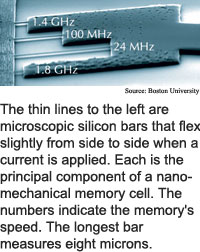
Nanomechanical memory demoed
By
Eric Smalley,
Technology Research NewsA bit -- the basic unit of computer information -- can be made from anything that can be switched between two states, which represent 1 and 0.
Computer chips use the presence and absence of electric current to represent 1 and 0; disk drives use positive and negative magnetic poles. The 19th- and early 20th-century precursors to today's computers used mechanical rather than electrical elements to store and process data.
The rise of nanotechnology has led many researchers to revisit mechanical computing. Nanotechnology has yielded microscopic materials that range from microns, or thousandths of a millimeter -- around cell size -- to nanometers, or millionths of a millimeter -- the realm of molecules. "It turns out that... nanomechanical memory cells, due to their size and speed, could outperform their counterparts in magnetoelectric systems," said Pritiraj Mohanty, an assistant professor of physics at Boston University.
Several research teams have designed nanomechanical memory cells based on carbon nanotubes or buckyballs that could lead to extraordinarily fast, ultrahigh capacity computer memory. Carbon nanotubes are rolled up sheets of carbon atoms that can be narrower than one nanometer; buckyballs are spherical carbon molecules. The researchers have not found a way to to mass-produce nanotube and buckyball memory devices, however.
A team at Boston University has made a minuscule mechanical memory cell from silicon, the stuff of computer chips. The memory device is a beam that is clamped at both ends. "If you take a metallic ribbon... and compress it from both sides, it buckles into one of the two possible states: away from you or towards you," said Mohanty. "Our idea was to use the two buckled states as 0 and 1 for information storage," he said.
The memory cell beam is 8,000 nanometers long by 300 nanometers wide by 200 nanometers high. A human hair, in contrast, is about 75,000 nanometers wide.
The device closely resembles silicon nanoscale oscillators that researchers have been making for years and could be made by the millions using standard chipmaking techniques. Nanoscale oscillators vibrate at high speeds, and are being developed largely as compact, high-frequency sensors and communications devices. The memory cell requires closer control than oscillators in order to be switched between the two flexed states.
The memory cell beam flexes when current is sent through it, and it can be switched between the two flexed states 23.5 million times per second, or megahertz. Today's state-of-the-art memory chips operate at 400 megahertz. Shortening the beam to 1,000 nanometers will increase its frequency to more than a billion times per second, or gigahertz, according to Mohanty.
The memory cell's size allows more than 100 gigabytes to be stored per square inch, according to Mohanty. This is 125 times as much information as today's memory chips hold. There are eight bits to a byte.
The device uses several orders of magnitude less power than today's electronic memory. Its small range of motion means that it can be switched using only femtowatts, or million billionths of a watt of power rather than the microwatts, or millionths of a watt required to switch today's devices, said Mohanty.
Mechanical memory is also resistant to radiation and electromagnetic pulses, which can disrupt electronic and magnetic devices, said Mohanty. This would make it useful for devices that operate under extreme conditions, like spacecraft.
The challenge in making the minuscule memory beam was finding ways to control and observe the its tiny movements, said Mohanty. "We spent a lot of time... trying to talk to the structures," he said. "It is nontrivial to [produce] the manipulation or read-write signal at high frequencies, particularly when the structures are so small."
The researchers' method of monitoring the beam's motion is sensitive enough to detect movements of less than one-tenth of a nanometer, according to Mohanty. They found that the device moves four tenths of a nanometer to go from a straight to a flexed position. The researchers are working on methods to detect the smaller movements of shorter beams.
The researchers are also looking to make speedier memory using single-crystal diamond rather than silicon, are investigating methods of making mechanical memory retain data when the device is turned off, and are working out ways to make the memory resistant to external disturbance, or noise, said Mohanty.
The memory could be used practically in two to five years, said Mohanty. Several issues still need to be resolved, he said. "First, the behavior and control of a large number of such memory cells, exceeding millions per square inch, should be carefully studied. Second, manufacturing of these cells and their integration with the current [chip] technology needs to be explored."
Mohanty's research colleagues were Robert L. Badzey, Guiti Zolfagharkhani and Alexei Gaidarzhy. The work appeared in the October 18, 2004 issue of Applied Physics Letters. The research was funded by the National Science Foundation (NSF), the Department of Defense (DOD) and the Sloan Foundation.
Timeline: 2-5 years
Funding: Government
TRN Categories: Data Storage Technology; Nanotechnology
Story Type: News
Related Elements: Technical paper, "A Controllable Nanomechanical Memory Element," Applied Physics Letters, October 18, 2004
Advertisements:
November 17/24, 2004
Page One
Fibers mix light and electricity
Software sorts out subjectivity
Nanomechanical memory demoed
Nanotubes tune in light
Briefs:
Low-pressure material holds hydrogen
Plastic cuts artificial hip wear
2D holograms make 3D color display
Lasers drive nano locomotive
Light-recording plastic holds up
Atom flip energy measured

News:
Research News Roundup
Research Watch blog
Features:
View from the High Ground Q&A
How It Works
RSS Feeds:
News
Ad links:
Buy an ad link
| Advertisements:
|
 |
Ad links: Clear History
Buy an ad link
|
TRN
Newswire and Headline Feeds for Web sites
|
© Copyright Technology Research News, LLC 2000-2006. All rights reserved.